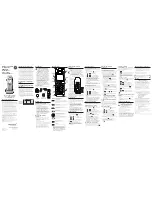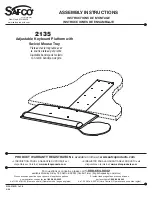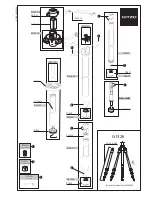
Greeting the Sensors
Waving at the (ultra-sound) motion sensor:
PASCO Motion Sensor II CI-6742A
Introduction:
The Motion Sensor II works with a ScienceWorkshop-compatible interface and PASCO data
acquisition software (such as PASCO Capstone) to measure and record motion data. It
produces a series of ultrasonic pulses and detects the sound re
f
ecting back from an object in
front of it. The interface
measures the times between outgoing pulses and returning
echoes
. From these measurements, the data acquisition software
determines the position,
velocity, and acceleration
of the object.
1
Quick Start
1. Connect the Motion Sensor II to your ScienceWork-shop interface and start Capstone
on the computer.
2. Register the sensor with Capstone.
3. Place an object in front of the sensor at least 15 cm away.
4. Click “Record” or press “Start” to begin recording data.
5. Move the object in a straight line directly away from or toward the sensor.
To Aim the Motion Sensor at an Object
1.
Set the range switch to short range () or long range () setting.
•
Select for measuring a cart on a track.
•
Select for measuring most other objects.
2.
Arrange the Motion Sensor and object so that the Motion Sensor's transducer faces the
object.
•
The object should be at least 15 cm from the transducer.
•
If the object will move, it should move directly toward or away from the Motion
Sensor.
•
Aim the motion sensor slightly up to avoid detecting the tabletop.
3.
Remove objects that may interfere with the measurement. These include objects
between the sensor and target object, either directly in front of the sensor or to the
sides.
To Record Data in
Capstone, click Record and the Motion Sensor will begin clicking. If a target
is in range, the target indicator
f
ashes with each click. The data acquisition software should
start collecting and displaying data. Click Stop to stop data collection.
To Display Data without Recording in Capstone:
Click the Recording Mode menu and select Fast Monitor Mode. The Record icon changes to a
Monitor icon. Click Monitor to display live data without recording it.
Sensor Confguration:
To Change the Sample Rate in Capstone, c
lick the up or down button next to the Sample Rate
setting.
The normal range of sampling rates is between 1 Hz and 50 Hz. At the default rate, the
Motion Sensor can measure distance up to 8 m. The maximum distance decreases with
increasing sample rate. At very high sample rates (between 50 Hz and 250 Hz), the maximum
distance is less than 2 m.
Equipment Mounting:
•
Mount the Motion Sensor as illustrated ona vertical rod (a) or a horizontal rod (b).
•
Integrated clips allow it to be attached to the end of a dynamics track (c).
•
A threaded hole in the bottom of the unit (d) is provided for attachment to the PS-2546
Magnetic Bracket (e), the ME-6743 Cart Adapter (f), and other 1/4-20 threaded
mounting devices such as a camera tripod.
1
Note: Essential PASCO Capstone tasks are described brief
l
in this
instruction sheet. For more instructions on using Capstone, see the User’s
Guide or the online help





















